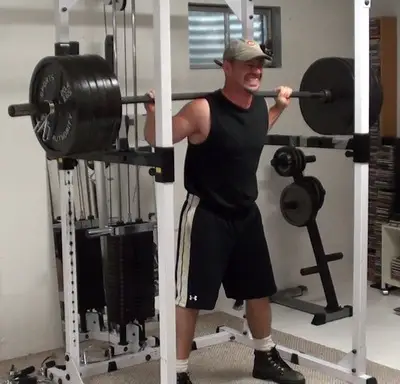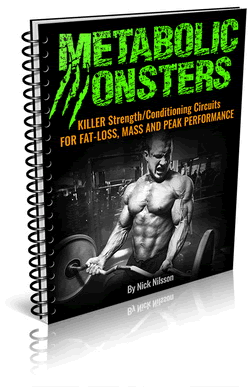By Nick Nilsson
Author of Time-Volume Training
Intensity techniques are among the greatest weapons in your arsenal for building a truly impressive physique.
However intensity techniques not for everybody. Beginning trainers should definitely NOT use techniques such as these.
Intensity techniques allow you to push beyond conventional failure in order to work your muscles harder, providing an irresistible stimulus for the muscles to get larger and stronger.
Try these techniques in your next workouts. You can even try using several of these techniques in one set if you really want to work yourself hard. Be careful not to overuse them, however, as they can be extremely demanding and difficult for your body to recover from.
1. Forced Reps
This is the most popular and consequently the most abused intensity technique. A spotter is used to provide enough assistance for the trainer to be able to complete the rep.

- The abuse comes when the trainer relies on the spotter for assistance during most of the set.
- The most obvious example is the bench press.
- Forced reps should not be done every set like some trainers do. Properly executed forced reps are very demanding and can severely tax your recovery systems.
- Spotters should also provide only just enough help to keep the weight moving. They should not take the weight away from the trainer.
2. Partial Training
This is simply moving the weight through a partial range of motion (usually, but not necessarily, the strongest range of motion of the exercise, e.g. the top 6 inches of the bench press or the top 12 inches of the squat). This allows much more weight to be used.

Partials can also be done at the end of a set to extend it. Continue with the same weight but do partial reps, shortening the range of motion more as you tire until you are just doing lockouts.
- Pure partials are often done in the power rack with the pins set at appropriate levels. Partial squats are done with the pins in the rack set near the top of the range of motion. Moving the bar only a few inches with a huge amount of weight on your back, is a great way to build power, density, and confidence.
- Partials can be done anywhere in an exercise's range of motion. They can help you get through sticking points if you do partials at and through the sticking point. The heavy weight is very useful for building tendon and ligament strength. Sometimes when you hit a plateau, it is not due to muscle strength but connective tissue strength. Partials can help overcome this.
- Partials can be done in a continuous without taking tension off the muscles, or in brief reps, allowing the weight to be supported on the racks for a few moments before doing the next rep. The continuous style provides more muscle tension but reduces the amount of weight that can be used. Don’t bounce the bar off the pins. Develop tension in the muscles gradually so you don’t jerk anything out of the sockets.
- If you use a lot of partial movements, it is very important to stretch after each set. It is also a good idea to finish with a set that takes the muscle through a full range of motion. A static hold and a negative is a good way to do this as it keep a lot of tension on the muscle all the way through the entire range of motion. Hold in the stretch position for as long as possible at the bottom of the movement.
3. Pre-Exhaust Training
Do a set of an isolation exercise for a muscle group, then, with no rest, do a compound movement for it, e.g. dumbbell flyes then barbell bench press. This fatigues the target muscle then allows the fresher secondary movers push the target muscle harder.
A variation of this is the pre-exhaust giant set. A good example is triceps, shoulders and chest. This variation will push the triceps to the limit, and work the shoulders hard.
- Start with a triceps isolation exercise such as pushdowns.
- Go to shoulder press, which works triceps and shoulders.
- Next, do bench press, which works the triceps, shoulders and chest.
Each progressive set will allow another muscle group to continue assisting. For lower body, try it with hamstrings. Start with legs curls which isolate the hams then move to stiff-legged deadlifts, which work the hams and glutes, then move to lunges which work the hams, glutes and quads.
The pre-exhaust concept can be extended to an entire workout. If you wish to push your triceps harder, try doing them first, followed by chest. You may limit your chest workout but your triceps will be pushed a lot harder by doing chest first. This can be applied to biceps and back, shoulders and chest, or calves and thighs.
4. Cheat Reps
At the end of a set, when you can't do any more reps with good form, use a bit of body swing or momentum to help get the weight past the sticking point, e.g. swinging the weight up a little at the start of a barbell curl.
- Do not cheat excessively or you may cause injury.
- Cheat only to work the muscle harder, not to make the exercise easier.
5. Drop Sets
This entails doing a set to failure with a weight then immediately doing another set to failure with a lighter weight.
- This can be done as double-drop (reduce the weight once), triple-drop (reduce the weight twice), or down-the-rack (use every consecutive set of dumbbells down a rack) sets.
- As a basic rule-of-thumb, reduce the weight around 10% with each drop.
- Another useful way to do drop sets is to pull 45 pound plates off if you're doing an exercise where several are being used (e.g. squats). It is also possible to load the bar with smaller plates to reduce the amount of weight dropped.
- This is one of the most time/energy efficient ways to train, especially if doing an abbreviated or maintenance program.
6. Down-The-Rack Drop Set
If you are doing laterals for your shoulders, start with a weight you can get six reps for, then pick up the next lightest set of dumbbells and go again. Repeat this procedure until you get to the lightest dumbbells that you wish to use.
- This idea works well with selectorized machines. Simply just keep raising the pin to the next lightest weight. Don’t feel confined to drop only one notch or dumbbell. You may drop two notches or skip a pair of dumbbells. This can depend on the exercise. You may finish a set with very heavy weight and may be unable to do another rep with the next lightest weight, as it is still very heavy.
- It is also not necessary to stick to a set number of reps during the drops (e.g. get 6 reps on every drop). You can try doing one rep with each drop or do as many as it takes to fail at each drop. Obviously, the lighter the weight gets, the more reps you will be able to do.
7. Mechanical Drop Sets
Do the first set with the strongest variation of an exercise (e.g. decline bench press) and go for power. Do the second drop with the next strongest variation (e.g. flat bench press) and go for feeling the muscle. Do the third drop with the weakest variation (e.g. incline bench press) and use very strict form. You can also do that backwards and start with the weakest variation first.
8. Fiber Sweep Triple Drop Sets
This type of triple drop set works three different ways.
- The first set of the drop, use a very heavy weight (about 85-90% 1RM) and do 2 to 3 reps with it. This will work on relative strength and connective tissue strength.
- For the second drop, use a weight that allows 8 to 10 reps. This builds muscle mass and circulation.
- For the third drop, use a very light weight and do 6 to 8 fast, explosive reps (one second up, one second down). This will work the explosive fibers and the neuromuscular system. Another option on the last set is to do a set of very high reps with a very light weight (30 plus).
- Note: Plate loaded machines are very useful for drop sets as there are no pins used and the weight can be changed anywhere in the movement without losing any tension and without disturbing the set. A partner is required to effectively use this type of drop setting.
9. Rest-Pause Training
This is an advanced technique that allows you to get more reps with the same weight.
- Do a set to failure.
- Rest for 5 to 10 seconds then do a few more reps with the same weight.
- Do this once or a few times depending on your energy levels and how far you wish to push.
With this technique you can take a weight you can only do for three reps and do a set of six or more reps with it.
This technique works very well for high rep training as well when lactic acid burn forces you to stop. Do a set of calf raises until you can't take the pain, rest for a few seconds and shake out your legs to allow the lactic acid to be cleared somewhat, then do more reps until you seize up again. Shake it out and continue. This allows you to push to muscular failure instead of lactic acid failure.
10. Supersetting
This is a good way to train if time is limited. Supersetting involves doing two exercises with no rest in between. There are a number of different types of supersets.
Same Part Supersetting
This is the most common type. Do two different exercises that work the same bodypart, e.g. incline curls then barbell curls.
Isolation/Compound Supersetting
This is essentially pre-exhaust supersetting. Do a set of an isolation exercise then a set of a compound exercise, e.g. flyes then bench press.
Antagonistic Supersetting
Do a set of an exercise for one bodypart then immediately do a set of an exercise for the antagonistic bodypart, e.g. barbell curls then tricep pushdowns.
- Antagonist supersetting can help each muscle group recover while working the other muscle.
- It also makes you stronger in both.
- For the arms, it has the advantage of keeping the blood localized in the upper arm area.
- Back and chest or quads and hamstrings are other examples of antagonistic muscles.
Upper Body/Lower Body Supersetting
Do an upper body exercise then a lower body exercise, or vice versa, e.g. chest then calves.
In-Set Superset
Do two different exercises within a rep.
- You must be able to make a smooth transition between the exercises in order for this to be effective.
- An example of this is doing a dumbbell bench press on the positive then a dumbbell flye on the negative on every rep.
- The Zottman curl, where you use a regular grip on the way up and a reverse grip on the way down is another good example of this.
- Others include regular deadlifts (up) and stiff-legged deadlifts (down), close grip bench press (up) and lying barbell extensions (down).
Do not superset muscles that assist with the other exercise unless you do them second, e.g. do not do pushdowns then bench press - tricep fatigue will limit your bench press work.
You can, however, do the bench press first then do pushdowns. An exception to this is if you are doing it to push your triceps further with the assistance of the pecs and shoulders. Then do triceps first. This would be a type of pre-exhaust superset.
11. Giant Sets
Do several exercises for one bodypart in a row without resting in between exercises, e.g. chin-ups, seated rows, straight arm lat pushdowns, then pull downs. You can do the same exercise more than once within the giant set as well. Try doing the exercises in the order of midrange, stretch then contracted position for a huge pump.
Variation Giant Sets
Use variations of the same exercise starting with the weakest version and going to the strongest, using the same weight. An example is wide grip pulldowns to reverse close grip pulldowns to regular close grip pulldowns.
12. Burns
These are typically done in the stretch or contracted positions. They are small, fast movements at the end of a set to finish off the muscle. These are most often seen in calf raises. Just bounce up and down in the bottom position at the end of a set until your calves burn.
13. Strip Sets
These are done with barbells. Do a set then, without racking the bar, get two spotters to pull off a preset amount of weight. Continue with that weight. Keep stripping as desired. This will thoroughly burn out a muscle. It is similar to drop sets, but there is absolutely no rest.
14. Negative/Eccentric-Focused Training
This technique focuses on the negative portion of muscle contraction (the eccentric or lowering phase).
- Use about 10% heavier than your 1 RM.
- Use a spotter to give you a lot of help with the positive then lower the weight slowly on your own.
- Each negative rep should take about six to ten seconds to lower.
- To really get the feel for a proper negative, you must not just allow the weight to lower, you must actively push (or pull) against it, fighting it all the way down. It is like you are trying to do a positive rep but aren't.
- Another way to do negatives is to do the positive normally then get your spotter to add to the resistance on the way down by leaning on the bar or pulling down on it.
- Do focused negative work at the beginning of your bodypart work when you are at your strongest.
15. The Jettison Technique
This is similar to the drop set and strip set technique but doesn't require changing weights or using spotters. The example will be barbell curls.
- Load a barbell then put a collar on.
- Add a few more small plates outside the collar.
- Pick up the barbell and hold some elastic cables in addition to the bar.
- Go to failure with all that then let go of the cables.
- Go to failure again then allow the loose plates to slide off.
- Go to failure with the rest.
16. Rep Targeting
Set a target of a certain amount of reps and get that target of reps no matter how many sets it takes you to get there.
- For example, if you pick a target of 50 reps on chin-ups, say you get 30 on the first set. Rest a little while 10 to 30 seconds. Do another set. Say you get 10 reps. Rest. Get 5 reps. Rest. Get 3 reps. Rest. Get 2 reps. Done.
- A different version of this is do this is time subtraction. The amount of time you rest between sets is the amount of reps you have left to get to your target. For example, your target is 50, you get 30 reps, your rest period is 20 seconds. The next set you get 10 reps. That leaves you with 10 reps to go, you rest 10 seconds and go again. You get 4 reps, you have 6 left, rest 6 seconds.
17. Heavy Supports
This is simply holding a weight in the lockout position of an exercise for as long as possible. An example of this would be just standing there with a huge weight on your back. This would be a squat support.

These are best done in the big movements like bench, squats, deadlift, dips, shoulder press, etc. because of the amount of weight that can be supported. These will build connective tissue strength as well as increasing m
18. Triple Drop and Rebound Sets
This is a variation of the Triple Drop Set. The Triple Drop Set is where you start with a heavy weight, do a set to failure, reduce the weight, do another set to failure, reduce the weight a third time and do a final set to failure.
Do the regular Triple Drop Set then quickly go back and do your starting (heaviest) weight again for a more few reps. Usually you will be able to get one or two reps with it. The reason for this is that the last of the drops uses a lighter weight, which recruits different muscle fibers than when you are using heavier weights.
19. Isolation/Compound Rebound Sets
Do a Triple Drop Set of an isolation exercise, e.g. flyes, then immediately go back and use your starting (heaviest) weights for a set of a compound exercise for that muscle group, e.g. dumbbell bench press.
This is a type of advanced Pre-Exhaust training. Pre-Exhaust training is when you do an isolation exercise (an exercise that involves motion at only one joint, such as a dumbbell flye) immediately followed by a compound exercise (an exercise that involves motion at two or more joints, such as a bench press).
The idea with the Pre-Exhaust training is to basically exhaust your target muscle group (in this case the chest), by first working directly with one exercise, then doing another exercise that utilizes other muscles to assist it. This increases the intensity of the work done by the chest as the assisting muscles will you allow you to push the chest further.
By utilizing a triple-drop set format for the isolation exercise, you dramatically increase the exhaustion of the target muscle, allowing you to push it extremely hard.
20. Jump Sets
This is a way of doing a large number of heavy sets for several muscle groups without losing as much strength from set to set.
Jump sets are best used on antagonistic bodyparts such as back and chest, biceps and triceps, or hamstrings and quads.
For example, if you plan on doing 5 sets of chin-ups and 5 sets of bench, start with 3 sets of chin-ups, then 3 sets of bench, then go back and do your remaining 2 sets of chin-ups and 2 sets of bench. The extra rest will allow you to be stronger on your last 2 sets than you normally would.
Jumping between antagonistic muscle groups also seems to benefit strength. This can also be done going back and forth on every set instead of groups of sets. This is not a superset - take your normal rest period between each set. This technique enhances recuperation by providing more rest to the bodyparts but within the same workout time. This allows you to do more weight for each
exercise.
21. Two Up - One Down Negatives
This is a variation of negative training that is best done with machines. Use two arms or legs for the positive phase of the movement then lower it the weight using only one arm or leg.
This type of negative training is useful if you do not have a partner to work with as it is done completely solo.
A good example of this technique is the machine bench press. Set the weight to about half of what you would normally use for the exercise. Press the weight up with both arms then remove one and lower the weight with one arm.
When using this technique, you can alternate arms/legs or do the complete set of reps with the one arm/leg, then the complete set of reps with the other arm/leg.
22. Combination Sets
With this technique, you will use two different exercises alternated with each rep, e.g. lying tricep extensions and close grip bench, dumbbell flyes and dumbbell press, rows and deadlifts. You should use exercises that are easily switched from to the other within a set.
To take the set even further, when you fail on one exercise, continue with the one you are stronger in until you fail on that one, too. For example, when combining rows and deadlifts, continue with deadlifts after failing on rows. Your legs will help push your back further. This whole technique is like an extended pre-exhaust superset.
23. Add Sets
These are the opposite of drop sets. Start with a light weight for high reps and add weight on progressive sets. This works the slow-twitch, higher rep fibers first, then the fast-twitch, powerful fibers.
This technique works very well for calves as they recover very quickly. It also works very well with selectorized machines. You can combine this technique with drops sets, doing add and drop sets or drop and add sets like a pyramid.
24. Static Hold Weight Pyramiding
This technique only works on plate-loaded machines or on a barbell exercise with two spotters.
Start with a moderate weight that you can do a static contraction with for a long period of time. Hold that weight in the contracted position of the exercise you are working, e.g. pec deck.
Have a partner add plates to the machine while you continue to hold in that static position. Keep adding plates (small ones such as 2½'s, 5's, 7½'s or 10's work best, depending on the exercise and your strength levels) until the weight starts to drop.
At that point, pull off one plate. Hold until it starts to drop again. Pull off one plate and hold. You may come to a point where your partner is pulling off weights as fast as he can just to keep up with your lagging strength.
Make sure you have effective communication such as a nod or a grunt when you want the next plate off or on. Continue this process until you end up at your original weight (you can continue to no weight if you want).
This is an incredibly intense static hold and will fatigue pretty much every muscle fiber in the target muscle group except for the explosive ones. To hit them as well, when you are the top of the pyramid using the heaviest weight, do as many partial, explosive reps as you can in the contracted position.
You may also wish to try this technique with a barbell and two spotters. Make sure that they add and remove weights simultaneously in order to allow you to keep the bar balanced.
Want one more intensity technique? Try Countdown Alternating Sets for legs...
![]()
More From Fitstep.com
| Triple Add Sets to Work ALL Your Muscle Fibers in One Set | |
| 3 Things People Do To Totally Screw Up Their Fat Loss | |
| 8 Easy Exercises You Can Do At Home | |
| Speedskater's Secret For a Bigger Butt |
Share This Page...
---
Home -> Muscle and Strength -> Training Techniques -> Intensity Techniques



